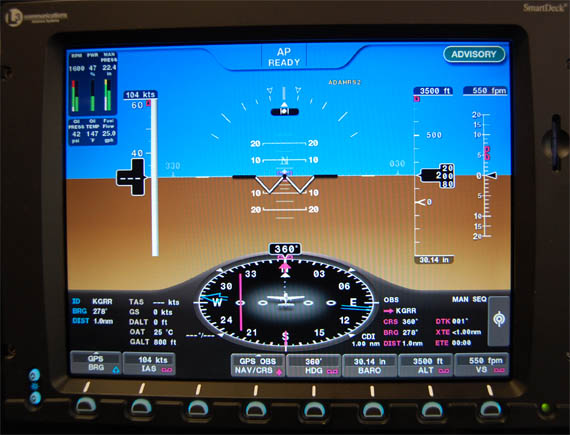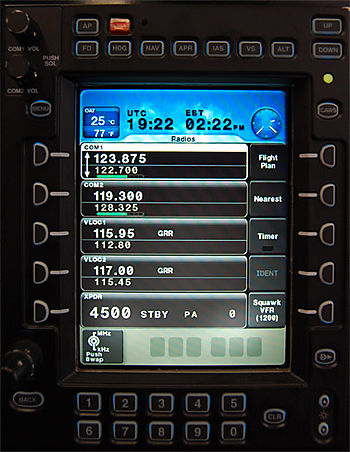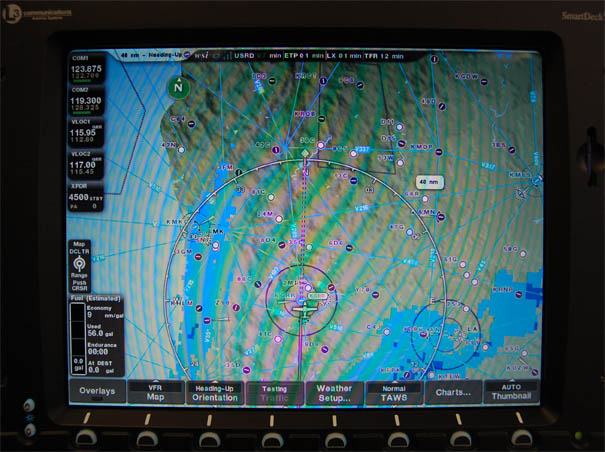 Last week, I wrote about the announcement of the Cirrus Perspective glass cockpit for the SR22, and how I had thought they’d be announcing the L-3 SmartDeck instead. My comments were prescient, as just two days later L-3 announced the availability of SmartDeck for the Cirrus SR22, though as a retrofit, rather than a factory option. Now SR22 owners have a choice of three different glass cockpits for their plane! With this much choice, don’t be surprised if Cirrus buys the “Have it Your Way” slogan from Burger King.
Last week, I wrote about the announcement of the Cirrus Perspective glass cockpit for the SR22, and how I had thought they’d be announcing the L-3 SmartDeck instead. My comments were prescient, as just two days later L-3 announced the availability of SmartDeck for the Cirrus SR22, though as a retrofit, rather than a factory option. Now SR22 owners have a choice of three different glass cockpits for their plane! With this much choice, don’t be surprised if Cirrus buys the “Have it Your Way” slogan from Burger King.
As I mentioned last week, Cirrus announced….
in September 2007 that they selected the L-3 SmartDeck glass cockpit for the prototype of The Jet, their four-place personal jet. L-3’s latest announcement is great news for future buyers of The Jet (assuming Cirrus selects L-3 for production units of The Jet), as it means they can buy a SR22 to become proficient in the same avionics that they’ll later use in their jet. Candidly, I expect L-3 will end up selling SmartDeck’s to most people with a deposit on Cirrus’ jet.
So why would one want a SmartDeck? First, the displays are bigger. Moving from 10.4 inch diagonal Avidyne to the 12.1-inch SmartDeck displays increases the viewing area of each glass panel by more than 35%! One way to use this extra space is to display the Traffic TAWS Thumbnail in the upper right corner of the Multifunction Display (MFD). Think of this as a dedicated inset map that makes it easy to quickly spot traffic information.
Another key differentiator is its dual Air Data and Heading Reference System (ADHRS). This is the magic box which uses the pitot static system and internal accelerometers and rate sensors to generate the information for the six primary instruments displayed on the pilot’s Primary Flight Display (PFD). These independent, dual systems mean that if one fails, the pilot still has a complete set of instrument data. This is in contrast to most glass cockpit systems shipped today which have only a single system, meaning that some instruments will no longer display if a failure occurs. Exceptions are the Cessna Mustang, which ships with dual ADC and AHRS modules, and the Cirrus Perspective. In the Cirrus SR22, the SmartDeck alerts a pilot when a sensor fails, and the pilot chooses the good sensor by comparing both with the standby instruments.
Unlike the other glass cockpits, the SmartDeck also has a more traditional representation of the slip-skid indicator. Instead of displaying a moving trapezoid, the system displays a moving ball, which more closely resembles the black ball in a traditional turn coordinator. That will help older pilots transitioning into glass cockpits more quickly identify this function.
The system also displays all engine functions on a single page. Pilots used to flying the Avidyne version of Cirrus aircraft, or the Cessna 400 version of the Garmin G1000 will appreciate this all-in-one display. One feature unique to SmartDeck is that recent engine history can be displayed. These are in the form of separate trend graphs that show the prior ten minutes of data for oil pressure, oil temperature and rpm. This will let you visually confirm whether that “rough engine” that you hear while flying at night or over water is real or imagined and I expect other manufacturers will quickly adopt it.
 Communications, autopilot, and flight plan management are handled by a separate Center Console Unit (CCU). In the SR22, it is located between and below the PFD and MFD. Cirrus pilots will instantly recognize this as the location where the audio panel and Garmin GNS430 radios are located in Cirrus aircraft. Candidly, I’m not wild about this location, as it means that a pilot takes their eyes off the PFD when operating the radios. It’s easy for someone hand flying a plane to inadvertently turn and/or descend when adjusting radios located elsewhere. Hence, I prefer the Garmin G1000 and Cirrus Perspective setups that allow you to operate these functions from the PFD, or the use of the autopilot when adjusting these functions.
Communications, autopilot, and flight plan management are handled by a separate Center Console Unit (CCU). In the SR22, it is located between and below the PFD and MFD. Cirrus pilots will instantly recognize this as the location where the audio panel and Garmin GNS430 radios are located in Cirrus aircraft. Candidly, I’m not wild about this location, as it means that a pilot takes their eyes off the PFD when operating the radios. It’s easy for someone hand flying a plane to inadvertently turn and/or descend when adjusting radios located elsewhere. Hence, I prefer the Garmin G1000 and Cirrus Perspective setups that allow you to operate these functions from the PFD, or the use of the autopilot when adjusting these functions.
The autopilot contains the tradition functions you’d expect plus–YES–an IAS function that allows you to set and climb at a specific airspeed. The Cirrus Perspective has the same key and G1000 owners (and airline pilots) know this as the FLC key. I was flying in a Cessna CitationJet earlier this week, and the pilot in the left seat told me he uses the autopilot functions in the same way I recommend: the IAS key for climbs, and the VS (vertical speed) key for descents.
 The STC for the L-3 SmartDeck was awarded for the SR22 G2 model, so G3 owners won’t be able to take advantage of this retrofit option. Quite likely L-3 is working on making it available for G3 owners, so stay tuned. The SmartDeck STC is being made available though authorized dealers and a L-3 representative I contacted told me that final pricing for the product hasn’t been set.
The STC for the L-3 SmartDeck was awarded for the SR22 G2 model, so G3 owners won’t be able to take advantage of this retrofit option. Quite likely L-3 is working on making it available for G3 owners, so stay tuned. The SmartDeck STC is being made available though authorized dealers and a L-3 representative I contacted told me that final pricing for the product hasn’t been set.
The Cirrus Perspective and L-3 SmartDeck announcements are not great news for Avidyne, which at one time had the dominant market share in glass cockpits in general aviation aircraft in 2003 and 2004. The market momentum began moving toward the Garmin G1000 in 2005 and 2006, as a half dozen manufacturers lined up to follow Diamond’s and Cessna’s shipment of the G1000 in 2004. Avidyne expected to regain share when the Eclipse 500 jet began shipping, however, that relationship soured and Eclipse eventually switched the Avidyne content to other suppliers. Avidyne is undoubtedly working on a next generation glass cockpit system to supersede the one currently shipping in the Cirrus, and it will be great to see what new innovations they bring to the market. One thing is certain. The market for GA glass cockpits is getting more crowded, and buyers will continue to benefit from this fierce competition.
Hello,
Is there any information about the cost of the system and any other aircrafts that it can be installed in ?
Thanks,
avi
Avi,
You’d need to contact the L3 corporation for pricing information. I don’t think it’s available for any other aircraft at this time.